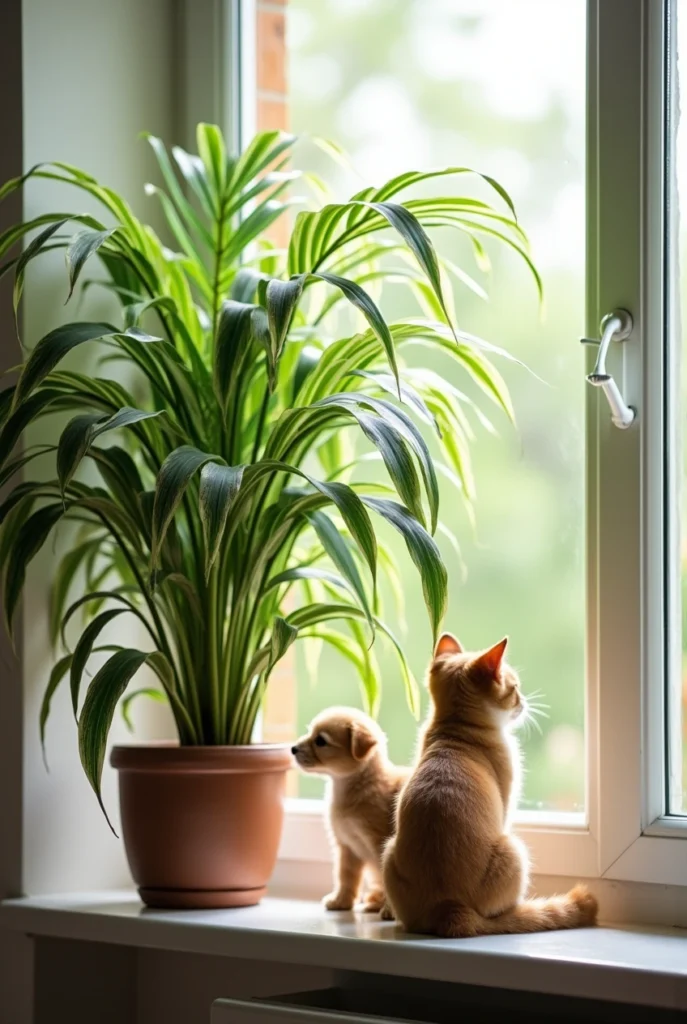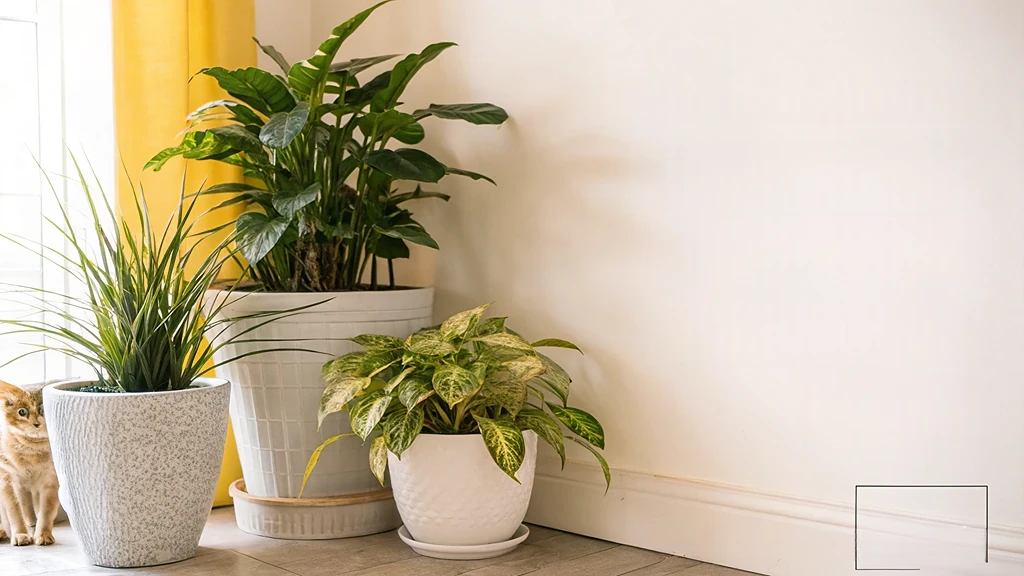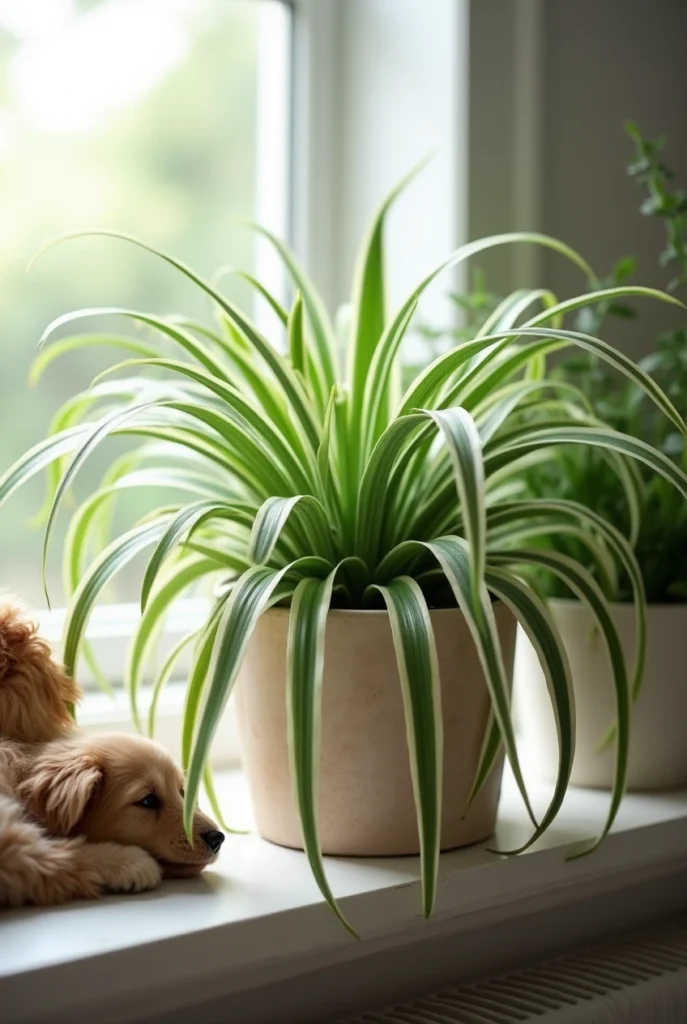Do you love filling your home with lush greenery but worry about your furry companions’ safety? In this comprehensive guide, I’ll share 26 beautiful houseplants that are safe for cats and dogs, allowing you to create a thriving indoor garden without compromising your pets’ health. From tropical showstoppers to low-maintenance succulents, these pet-friendly options ensure your home can be both green and safe. As a pet parent and plant enthusiast, I’ve navigated this delicate balance for years. The moment I discovered my cat Oliver nibbling on a lily (highly toxic to cats), I embarked on a mission to create a pet-friendly indoor garden that satisfies both my green thumb and keeps my four-legged family members safe.
Table of Contents
Why Pet-Safe Plants Matter: The Hidden Dangers in Common Houseplants
Many popular houseplants contain compounds that can be toxic when ingested by cats and dogs. The effects range from mild gastrointestinal upset to severe kidney failure and even death. According to the ASPCA, plant poisoning prompts thousands of emergency veterinary visits annually, with many cases involving common houseplants we unwittingly bring into our homes.
Some of the most dangerous yet common houseplants include:
- Lilies (extremely toxic to cats, causing kidney failure even in small amounts)
- Sago Palm (highly toxic to both cats and dogs, causing liver failure)
- Pothos (causes oral irritation, swelling, vomiting, and difficulty swallowing)
- Philodendron (contains calcium oxalate crystals that cause immediate pain and irritation)
- Aloe Vera (toxic to both cats and dogs when ingested)
“Prevention is always better than treatment when it comes to plant toxicity in pets. Creating an environment with pet-safe houseplants eliminates this risk entirely while still allowing you to enjoy indoor gardening.” — Dr. Sarah Jensen, DVM, Veterinary Toxicologist
26 Beautiful Houseplants Safe for Cats and Dogs
Low-Maintenance Pet-Safe Houseplants
1. Spider Plant (Chlorophytum comosum)
The spider plant ranks among the most adaptable and forgiving houseplants safe for cats and dogs. With its arching variegated leaves and baby “spiderettes” that dangle from mature plants, it adds visual interest while purifying your air.
Care Tips:
- Bright indirect light
- Allow soil to dry slightly between waterings
- Occasional fertilizing during growing season
2. Boston Fern (Nephrolepis exaltata)
With its lush, feathery fronds, the Boston fern brings tropical vibes to any space while remaining completely pet-friendly. While slightly more demanding than some options, its dramatic appearance makes it worth the extra effort.
Care Tips:
- Indirect light
- High humidity (bathroom placement ideal)
- Consistent moisture (never let dry completely)
3. Haworthia (Haworthia spp.)
For succulent lovers with pets, haworthias offer the perfect solution. These compact, rosette-forming succulents resemble miniature aloe plants (which are toxic to pets) but contain no harmful compounds.
Care Tips:
- Bright indirect light
- Water sparingly (when soil is completely dry)
- Well-draining soil mix essential
4. Peperomia (Peperomia spp.)
This diverse genus includes numerous pet-safe varieties with different leaf shapes, colors, and textures. Popular options include the watermelon peperomia and ripple peperomia.

Care Tips:
- Medium to bright indirect light
- Allow soil to dry between waterings
- Low fertilizer needs
Pet-Safe Flowering Houseplants
5. African Violet (Saintpaulia spp.)
These charming plants produce velvety leaves and delicate flowers in shades of purple, pink, and white. African violets are completely safe for curious pets and bloom repeatedly with proper care.
Care Tips:
- Moderate to bright indirect light
- Water from below to avoid leaf spotting
- Keep soil consistently moist but not soggy
6. Christmas Cactus (Schlumbergera spp.)
Unlike desert cacti with sharp spines, Christmas cacti have soft, segmented stems that produce stunning blooms in winter. All holiday cacti (including Thanksgiving and Easter varieties) are safe for pets.
Care Tips:
- Bright indirect light
- Allow soil to dry slightly between waterings
- Increased humidity promotes blooming
7. Orchids (Phalaenopsis spp.)
Elegant and exotic, orchids make stunning additions to pet-friendly homes. Phalaenopsis orchids (moth orchids) are particularly beginner-friendly and completely non-toxic to cats and dogs.
Care Tips:
- Bright indirect light
- Water only when potting medium is dry
- Well-ventilated growing conditions
8. Roses (Rosa spp.)
Miniature roses can thrive as houseplants in bright conditions and pose no threat to pets. While their thorns require careful placement, the plants themselves contain no toxic compounds.
Care Tips:
- Full sun (southern or western windows ideal)
- Keep soil consistently moist
- Benefit from periodic outdoor summer vacations
Pet-Safe Foliage Houseplants
9. Prayer Plant (Maranta leuconeura)
Known for their dramatic leaf movements (folding up at night like hands in prayer), these patterned beauties add visual interest while remaining completely pet-safe.
Care Tips:
- Medium to bright indirect light
- High humidity preferences
- Keep soil consistently moist
10. Calathea (Calathea spp.)
With their stunning patterned leaves, calatheas are showstoppers in any room. While somewhat finicky, their pet-friendly status makes them worth the extra attention.
Care Tips:
- Medium indirect light (no direct sun)
- High humidity essential
- Consistent moisture with distilled or filtered water
11. Areca Palm (Dypsis lutescens)

This graceful palm brings tropical vibes to any space while remaining safe for cats and dogs. Its feathery fronds create elegant movement and texture.
Care Tips:
- Bright indirect light
- Keep soil lightly moist
- Benefits from occasional misting
12. Staghorn Fern (Platycerium spp.)
These unusual epiphytic ferns make striking wall-mounted displays and are completely non-toxic to pets. Their unique growth habit resembles deer antlers.
Care Tips:
- Medium to bright indirect light
- Soak mounting board weekly
- Prefers high humidity
Air-Purifying Pet-Safe Houseplants
13. Bamboo Palm (Chamaedorea seifrizii)
NASA’s Clean Air Study identified the bamboo palm as an excellent air purifier that removes formaldehyde and other toxins. Fortunately, it’s also completely safe for pets.
Care Tips:
- Medium to bright indirect light
- Keep soil consistently moist
- Appreciates higher humidity
14. Money Tree (Pachira aquatica)
With its braided trunk and palm-like leaves, the money tree adds structural interest while purifying your air. It’s believed to bring good fortune and is completely pet-safe.
Care Tips:
- Bright indirect light
- Allow soil to dry between waterings
- Rotate periodically for even growth
15. Parlor Palm (Chamaedorea elegans)
This compact palm tolerates low light conditions better than most palms, making it perfect for darker corners. Its delicate fronds add tropical texture without endangering your pets.
Care Tips:
- Low to bright indirect light
- Allow soil surface to dry between waterings
- Tolerates average home humidity
16. Chinese Money Plant (Pilea peperomioides)
With its distinctive round leaves on long stems, the Chinese money plant has become an Instagram favorite. Its quirky appearance adds character while remaining safe for pets.
Care Tips:
- Bright indirect light
- Allow soil to dry between waterings
- Rotate regularly for even growth
Trailing and Hanging Pet-Safe Houseplants
17. Swedish Ivy (Plectranthus verticillatus)
Not a true ivy (true ivies are toxic to pets), Swedish ivy produces cascading stems of rounded, scalloped leaves. It’s perfect for hanging baskets in pet-friendly homes.
Care Tips:
- Medium to bright indirect light
- Allow soil to dry slightly between waterings
- Pinch back occasionally to promote fullness
18. Lipstick Plant (Aeschynanthus radicans)
Named for its tubular red flowers that resemble lipstick emerging from a tube, this trailing plant adds vibrant color while remaining safe for curious pets.
Care Tips:
- Bright indirect light
- Keep soil consistently moist
- Benefits from higher humidity
19. Friendship Plant (Pilea involucrata)
With textured, crinkled leaves featuring bronze highlights, the friendship plant makes an interesting addition to pet-friendly plant collections.
Care Tips:
- Medium indirect light
- Keep soil consistently moist
- Prefers higher humidity
20. Baby’s Tears (Soleirolia soleirolii)
This delicate creeping plant forms a lush mat of tiny round leaves, perfect for terrariums or as ground cover in larger containers with other pet-safe plants.
Care Tips:
- Medium indirect light
- Keep consistently moist
- High humidity essential
Unique and Interesting Pet-Safe Houseplants
21. Rattlesnake Plant (Calathea lancifolia)
The distinctive wavy-edged leaves with dark spots make this calathea variety particularly dramatic. Like all calatheas, it’s completely safe for pets.
Care Tips:
- Medium indirect light
- Keep soil consistently moist
- High humidity essential
22. Mosaic Plant (Fittonia albivenis)
Also called nerve plant, fittonia features intricate leaf patterns with contrasting veins against green, red, or pink backgrounds. These small plants are perfect for terrariums and pet-safe.
Care Tips:
- Low to medium indirect light
- Keep consistently moist
- High humidity essential
23. Ponytail Palm (Beaucarnea recurvata)
Despite its name, this isn’t actually a palm but a succulent with a bulbous base and long, strappy leaves. Its sculptural form adds interest to pet-friendly homes.
Care Tips:
- Bright indirect light to full sun
- Allow soil to dry completely between waterings
- Drought-tolerant and low-maintenance
24. Cast Iron Plant (Aspidistra elatior)
Living up to its name, this nearly indestructible plant tolerates neglect, low light, and temperature fluctuations while remaining completely pet-safe.
Care Tips:
- Low to indirect light
- Allow soil to dry between waterings
- Rarely needs repotting
25. Polka Dot Plant (Hypoestes phyllostachya)
With leaves speckled in pink, white, or red, polka dot plants add a pop of color to pet-friendly plant collections. Their compact growth makes them perfect for small spaces.
Care Tips:
- Medium to bright indirect light
- Keep soil consistently moist
- Pinch back to prevent legginess
26. Air Plants (Tillandsia spp.)
These soilless wonders absorb nutrients through their leaves rather than roots, allowing for creative display options. Air plants are non-toxic to pets and incredibly versatile.
Care Tips:
- Bright indirect light
- Soak in water weekly
- Good air circulation essential
Comparison Table: Pet-Safe Houseplants by Care Level
| Plant Name | Light Needs | Water Needs | Humidity Needs | Beginner-Friendly? |
|---|---|---|---|---|
| Spider Plant | Medium-High | Low-Medium | Low | ★★★★★ |
| Boston Fern | Medium | High | High | ★★★☆☆ |
| Haworthia | High | Very Low | Low | ★★★★★ |
| Areca Palm | High | Medium | Medium | ★★★☆☆ |
| Prayer Plant | Medium | Medium | High | ★★★☆☆ |
| Orchid (Phalaenopsis) | High | Low | Medium | ★★★☆☆ |
| Cast Iron Plant | Low | Low | Low | ★★★★★ |
| Air Plants | Medium-High | Low | Medium | ★★★★☆ |
Creating a Pet-Friendly Plant Haven: Display Ideas and Safety Tips
Even with non-toxic plants, it’s wise to discourage pets from treating your houseplants as salad bars. Here are some strategies to create harmony between your pets and plants:
Smart Display Options
- Hanging planters: Keep trailing plants out of reach
- Plant shelves: Wall-mounted shelves place plants at a safe height
- Terrariums: Glass enclosures protect small plants from curious pets
- Plant stands: Elevate potted plants off the floor
Additional Safety Measures
- Stabilize your plants to prevent tipping accidents
- Avoid toxic plant fertilizers or systemic pesticides
- Create pet deterrents with citrus peels or diluted citrus oils near plants
- Provide pet grass as an alternative for plant-curious cats
- Monitor new plants for pet interaction initially
FAQs About Houseplants Safe for Cats and Dogs
What indoor plant is safe for cats and dogs?
Spider Plant (Chlorophytum comosum) is one of the most popular indoor plants that is non-toxic to both cats and dogs. It’s easy to grow and thrives in most homes.
What is the safest plant for cats?
The Areca Palm (Dypsis lutescens) is a top choice. It’s 100% safe for cats, adds a tropical feel to any room, and purifies the air.
Which indoor plants are poisonous to cats?
Common indoor plants that are toxic to cats include:
Peace Lily
Philodendron
Pothos
Aloe Vera
Sago Palm
These can cause vomiting, drooling, or worse if ingested.
What indoor plant is toxic for dogs?
Dieffenbachia (Dumb Cane) and ZZ Plant (Zamioculcas zamiifolia) are toxic to dogs. They can cause mouth irritation, drooling, and difficulty swallowing if chewed.
Conclusion: Growing with Confidence
Creating a pet-friendly indoor garden doesn’t mean sacrificing style or variety. The 26 houseplants safe for cats and dogs highlighted in this guide demonstrate that you can enjoy a diverse, beautiful plant collection without worrying about your pets’ wellbeing. From structural statement plants to delicate flowering varieties and everything in between, there’s a pet-safe option to suit every taste and skill level.
Remember that individual pets may still have sensitivities even to non-toxic plants, and occasional stomach upset can occur with any plant consumption. Always monitor new plants around your pets and consult your veterinarian if you notice any concerning symptoms after plant interaction.
By choosing pet-safe houseplants and implementing thoughtful display strategies, you can create a harmonious environment where both your green thumb and furry friends can thrive. Your home deserves to be both beautiful and safe for every member of your family—including those with paws.
For more gardening tips follow us on Pinterest

